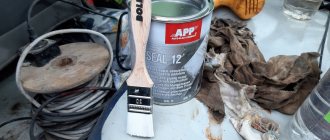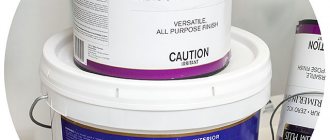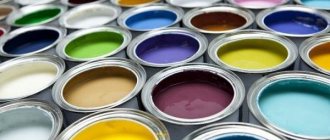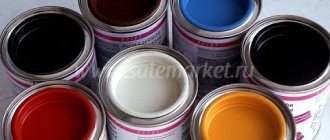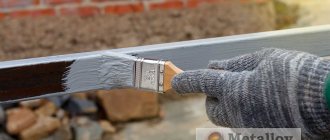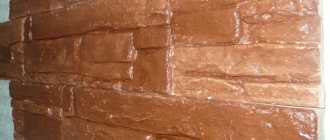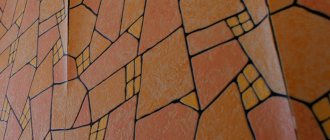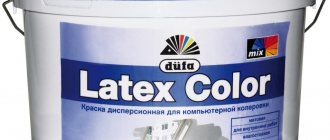Types of paint for glass and ceramic products
Coverage may vary. Some paints are applied to a “raw” unfired product and then subjected to heat treatment; this type includes cobalt paint. When applied to a product, it has a gray color, but after the oven it acquires the famous blue tints of Gzhel.
However, there are many more non-fired ceramic paints on the market. They are applied to the finished product and allowed to dry. This group includes acrylic paints for glass and ceramics. They have a rich palette, different packaging and it is very convenient to work with such a coating.
Craft stores offer a huge selection of both ceramic paints themselves and manufacturers. You can purchase ready-made sets of 6-10 bottles of different colors, or you can choose the colors you need yourself.
The purpose and type of the finished product is of great importance. A craftsman who makes items for sale will give preference to quality; parents who decide to work with their children are more likely to choose a ready-made inexpensive set for creativity. To create stained glass you will need special translucent water-based paints and a so-called outline. It is better to purchase the latter not a universal one, but a special one for working with glass and ceramics. Some paints cannot be applied to items used for serving food, others are completely unstable to water and detergents. You should carefully study the instructions before purchasing paint or consult with store salespeople.
Attention! Inexpensive acrylic paints without firing are washed off with water, but expensive ones can be easily scratched with a knife or fork. Therefore, for painting everyday dishes, it is better to use coatings that require heat treatment.
Ceramic paint: features and properties of the material
Paints for decorating ceramics have a number of features. They differ in composition and principles of application, which helps to choose the appropriate option.
Composition and technical characteristics
Substances that are water-based can be used to decorate dishes or other products. After firing, ceramic objects can be washed in water. In this case, the image will be perfectly preserved.
Dyes for decorating ceramics are produced by combining glazes, fluxes, and clay. In this case, natural or synthetic pigments are added to the composition. Taking into account the application method, materials are divided into underglaze and overglaze. In the first case, the substance is applied before firing, so the design is under the glaze; in the second, already fired objects are treated with the composition.
To improve the adhesion of the dye to the ceramic surface, various binding components are introduced into it. These include sugar, glycerin and other substances. To give the desired tones, salts of different metals are used.
Expert opinion
Zakharova Irina Yurievna
Cleaning professional with 15 years of experience. Our best expert.
Ask a Question
Paints often include flux. It is considered silicate glass, which melts quickly. Metal oxides are also added to the composition. In most cases, after firing, professionals paint ceramic products with different materials. This can be done with oil or tempera. Gouache or watercolor are also great. After this, the drawing needs to be secured with varnish.
When choosing dyes for ceramics, it is important to consider that they must be high quality and harmless. This is especially important for materials that are used to paint dishes. Brushes must also be of impeccable quality. Such products are considered very expensive.
See also
Composition and types of epoxy paints, rating of the best brands and calculation of consumption
To create a relief design, it is recommended to use a special clay paste. In this case, the simplest and most affordable option is the use of aerosols.
Scope of application
Paints for painting ceramics are used in the following situations:
- decorating the room;
- conducting master classes;
- professional painting.
To choose the right dye, you need to familiarize yourself with the features of the working surface. Its structure directly affects the choice of substance. Ceramics, unlike glass, has an opaque structure.
Pros and cons of paint
The advantages and disadvantages of substances depend on the composition of the dye. The advantages of the material include:
- variety of shades;
- uniformity of application;
- the ability to implement different design solutions.
However, the material also has certain disadvantages. These include the following:
- the need for strict adherence to application rules;
- high price.
Foreign manufacturers of acrylic paints
Italian paints IDEA Vetro for stained glass painting are completely unstable to external influences and cannot be used for food purposes. They do not require firing and are made on an organic basis.
Professional paints from Kreul Hobby Line, made in Germany, are very durable and have a rich palette of colors. After painting, the product must be kept in an oven for 90 minutes at a temperature of 160 degrees.
Hobby deLUXE professional acrylic paints are an excellent choice for items for sale. Although the series is universal, the coating is perfect for working on ceramics and glass. The paints do not require heat treatment and are resistant to abrasion and water. However, they cannot be used for everyday dishes; the coated jars themselves are quite large and cost more than their analogues, and the palette consists only of delicate pastel colors.
Master class No. 2: painting mugs and cups with acrylic paint
A fairly simple drawing will be used here, which does not require special artistic skills , so you only need desire, materials and a little time.
Materials:
- white cup (mug) and saucer (ceramic or porcelain),
- marker Pebeo Porcelaine 150,
- several colors of acrylic paints (blue, sapphire, white, rainbow colors),
- one or two brushes,
- palette for mixing paints (you can use a plate),
- several cotton swabs (to correct mistakes),
- alcohol or glass cleaner, a regular kitchen stove.
Painting technology:
- First, you need to clean the ceramics and dishes from fingerprints or grease with alcohol or window cleaner
- We draw raindrops on the cup and saucer (except for the center of the saucer where the cup is placed), that is, their outlines. Draw a rainbow in the center of the saucer.
- Thus, it turns out that when the cup is on the saucer, the rainbow will not be visible, but when the cup is lifted from the saucer for tea, there will be a pleasant little surprise, rainbow in the literal and figurative sense of the word. Remember that the paint dries in 5-10 seconds.
TIP: If you have never used a marker before, you need to make the paint start to flow out of it. To do this, you need to shake it for about 30 seconds, and then press the tip onto a sheet of paper until the paint begins to flow. Once the paint has gone, you can start painting.
- Use a medium sized brush to paint the raindrops. Use blue paint. You can paint right away with the paint in the bottle, or you can add a little water so that the color is not so saturated. Do not shake the paint, this may create bubbles which will reduce the quality of the painting.
If you have gone a little beyond the contours and the paint has not yet dried, this can be corrected with a cotton swab or napkin. If the paint has already dried, first moisten a cotton swab with alcohol, and only then correct the mistake. If you made a big mistake while painting and you want to start over, then rinse the dishes under warm water or wipe with alcohol and let them dry well before starting to paint again.
- These paints mix well with each other, so you can paint some of the droplets with blue, then mix with sapphire and paint the rest. You can paint some of them with just paint, or often with paint mixed with water.
- It is important to wash and dry your brush well when switching to each new paint color.
- After you finish drawing the raindrops, move on to the rainbow. To do this, use a very thin brush so that the design is neat and does not go beyond the contours.
- Remember that green can be obtained by mixing yellow and blue, and orange can be obtained by mixing red and yellow.
- The drawing is already finished, but this dish is not ready for use yet. Leave to dry for 24 hours.
- After this time has passed, place the dishes in a cool oven, set the temperature to 150° C. When the oven has warmed up to the set temperature, set the timer for 30 minutes and leave to bake. When the time is up, turn off the oven and let the dishes cool before removing.
- That's it now. You can enjoy your tea!
In general, with the help of these same tools you can draw any other drawing that appears in your imagination.
Domestic producers of acrylic paints
Among Russian manufacturers, paints for ceramics and glass can be noted: Olki, Gamma and Decola. All of them do not require firing and are not very resistant to abrasion. Products from the Olki series can rarely be found on sale; the paints themselves are practically no different from universal acrylic ones. Gamma coatings have a too liquid consistency and are inconvenient to work with, and the color palette is meager, dull and inexpressive.
Perhaps, among domestic products, the choice of Decola paint for glass and ceramics will be optimal in terms of price and quality ratio. The Neva palette creates coatings of bright and rich colors. Paints for ceramics are waterproof and are subject only to external mechanical influences, which means they are suitable for decorative purposes. The line includes ready-made sets and stained glass coverings. Decola paints for ceramics and glass are presented in two versions: matte and metallic, the same applies to the manufacturer’s contours.
Paints for ceramics and glass
Special coatings are required for working with porcelain and earthenware, ceramics and glass. Universal paints cannot always adhere to the smooth and even surface of materials.
You can purchase a ready-made set with basic colors and mix them on a palette to achieve the desired shade. But if the master’s skills and experience in mixing paints are limited, you should purchase colors separately. The Decola palette is very diverse, it contains delicate pastel colors, ordinary matte colors, metallic gloss coatings and bright rich colors.
Special colorless protective varnishes can preserve the brightness of colors and designs. When purchasing, you need to find out whether the coating can be used for food purposes. But even if you couldn’t find a special protective varnish, the product can still be placed on the table, but you should use it rarely and carefully.
Technical characteristics, composition and areas of application of varnish and paint
It is clear that the first jar you come across with a solution of natural or synthetic resins is not suitable for applying to ceramics. For this purpose, the construction industry has prepared products with a special composition.
Construction varnishes are solutions of synthetic and natural resins that are prone to film formation in water or organic compounds. To coat ceramic surfaces use:
- polyurethane varnishes (solutions of urethane polymers in aliphatic solvents);
- acrylic varnishes (acrylic dispersion dissolved in water).
These are flowing colorless liquids with a small content of solids that protect ceramics and tile joints from dirt, moisture stains, dust, mechanical and chemical damage.
Varnish coating:
- makes it easier to care for tiles;
- prevents fading;
- enhances the shine and contrast of the pattern.
The scope of use of these coatings is not limited to ceramics alone. The properties of acrylic and polyurethane varnishes allow them to be applied to brick, plaster, natural stone, and paving slabs.
If the condition is poor, painting the tiles is required for aesthetic reasons. Paint for ceramic tiles is applied under a protective coating, so its composition does not have such stringent requirements as for varnish. A pleasant bonus is the waterproofing properties of individual brands.
For complete or partial coloring, as well as manual application of an artistic pattern on tiles, the following are suitable:
- acrylic paints;
- alkyd enamels;
- polyurethane (latex) paints;
- oil and epoxy based paints.
To paint ceramic tiles with acrylic paints, simply wash them well and dry them thoroughly. Before applying paint, the surface to be restored is degreased using a solvent.
Varnish will allow a dull, textured, matte, unglazed finish to become glossy and shiny, and paint will repair glazed ceramic tile cladding.
How to choose?
Oil-based, latex and epoxy paints are suitable for all-over painting of ceramic tiles. In this case, a layer of special primer is first applied to the surface. It is better to apply a fantasy pattern with special acrylic-based stained glass paints intended directly for glass and ceramics.
Before painting ceramic tiles in the bathroom, experts recommend removing the old grout and replacing it with a sealed, moisture-resistant compound.
When choosing a protective varnish, you should pay attention to the following indicators:
- waterproof;
- degree of gloss (can be matte, semi-matte, semi-gloss, glossy and high-gloss);
- solids content by volume;
- hazard class for human health and the environment;
- content of organic volatile substances;
- material consumption for processing 1 m² of surface (the lower the consumption, the more expensive the tile varnish);
- drying time (readiness for operational loads).
Contours for glass and ceramics
This type of material can be used independently and in combination with other paints.
The contour is indispensable for working on glass and creating stained glass windows. They can also be purchased as part of a set or individually. The substances contained in the contours adhere the pigment well to the smooth surface. The stroke outlines the boundaries of the drawing and does not allow the paint to spread over the surface. The most beautiful and unusual works are obtained by combining colors and contours in creativity.
The coating is very easy to use. First you need to come up with a design and select a suitable item. Then take a tube of contour and carefully transfer the drawing, trying not to touch the lines with your hand or fingers. It only takes a little practice in pressing force to obtain the line of the desired thickness.
Stained glass paints
Glass painting has its own nuances. As a rule, it is required to maintain the transparency of the material even after applying paints. The light passing through the stained glass windows is colored and, falling on objects, creates fabulous patterns around.
Stained glass paints are made translucent, as they must transmit light. To apply them, the glass surface must be degreased; this condition also applies to other materials. You can purchase a solvent for the coating kit; it will be needed when making changes to an already applied pattern or correcting errors. The finished work can be dried for 3 hours or fired at a temperature of 100 degrees, but not more than 30 minutes.
Stained glass paints and contour are simply made for each other and always go together. By combining both coatings, you can easily and simply create unique things. You need to draw the design of the picture and place it behind the glass, and simply transfer it to the surface with an outline. Stained glass paints are quite fluid and will easily fill the voids between boundary lines.
The modern market for creative goods is ready to offer not only paints, but also a whole sea of related materials. For example, removable metal tips for outlines, stencils for stained glass, markers for ceramics and gel pencils that imitate glass after drying.
Subtleties of application
Colorants for painting glass and ceramics are divided into paints, outlines, markers and melting granules. In addition, paints for glass and ceramics are divided into two types depending on the purpose of painting.
Paintwork materials can be applied without firing or with firing. The beauty of the painting depends on which of these methods is used.
Professional artists use complex dyes when painting ceramics, which may belong to glaze or enamel. Painting of ceramic dishes such as teapots, cups, plates can be done both in production and at home. Kits for painting dishes on their own are sold with a ready-made object, which even children can draw on.
During coloring, the following pigments are used that do not require baking:
- Acrylic paints are used most often. They are accessible and inexpensive. This type, when completely dry, must be secured with sealant.
- The composition, made on the basis of solvents, does not require firing at high temperatures, but dries throughout the day.
- Felt pens, pens, markers allow you to create thin lines and outline contours.
There are also powder pigments that are great for porcelain dishes. But after applying such paint, the product must be dried, then baked for half an hour at a temperature of 350 degrees.
Hand-painted dishes will make an excellent gift, especially if you put a dedicatory inscription on its surface.
On video: the use of acrylic paints for glass and ceramics.
Dot painting of ceramics
There are many techniques for painting ceramics and glass. Masters find themselves in 2-3 types of work, study all the intricacies of materials and coatings and successfully work with them, combining and combining the experience gained.
Dot painting is very popular in painting dishes and plates. A pattern - dots using colored outlines - is applied to already processed and painted ceramics. The finished products attract the eye, it is impossible to pass by them and remain indifferent.
Although the writing style is reminiscent of Arabic culture, it is impossible to say where the technique was invented. Similar paintings are found both in Africa and India. The items will be reminiscent of the culture of the country whose characteristic elements are chosen for the pattern design.
Animalistic painting
The subjects of paintings for ceramics and glass are often the flora and fauna.
Undoubtedly, such wonderful plates will delight both children and adults. Children can work with paints and try to paint a mug or dish themselves. The child will be proud and happy to eat breakfast from homemade dishes.
It is much easier to work with special felt-tip pens and gel pencils than with paints. If the drawing is erased, it can be easily updated or corrected. And although many people think that a felt-tip pen is too simple and boring, with imagination you can create beautiful things with limited means.
Minimalism in painting ceramics and glass
Even if the master does not have artistic painting skills or drawing by hand is not his calling, the modern desire for minimalism in art will hide these shortcomings.
Unique things can be made using ready-made stencils. The main thing is to correctly play with the color and shape of the object. One simple but neatly executed pattern can attract more attention than a tastelessly painted huge dish.
When a person has a desire to create and create, one should not limit oneself to far-fetched reasons. The main thing in this matter is to start, and skills and abilities will come with experience!
Preparing the glaze
If you need to make a transparent glaze, it can even be done in a home pottery studio. You will need to crush the glass and dip it in the prepared water while hot. The glass pieces should become cloudy and covered with small cracks. In this case, you received a frit, from the mass of which the glaze is subsequently made at enterprises.
The next step is that this glass mass must be crushed to the state of white flour. This can be conveniently done using a mortar or ball mill. The resulting flour should be sifted through a sieve with very fine holes (for convenience, you can use a nylon stocking). After mixing glass flour with some paste or silicate glue, you should end up with a thick white liquid - this is the glaze.
If you need to get white dull enamel, you need to add 5 or 6% zinc oxide, barium or tin sulfate to the prepared mass. If, on the contrary, you wish to make a transparent glaze, add some of the oxides of various metals, which makes it possible to ultimately obtain a glaze of different colors.
A matte glaze results from insufficient burning. As a general rule, the top of the glaze should have small ridges and dimples.
Unfortunately or fortunately, today few people prepare glaze by hand - various shades of glaze can be purchased in a specialized store.
